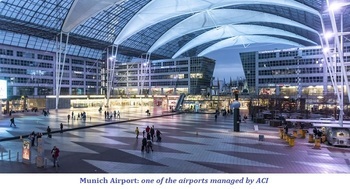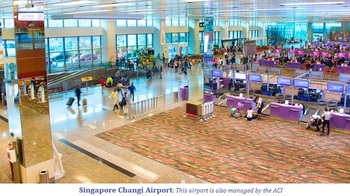
 Data Structure
Data Structure Networking
Networking RDBMS
RDBMS Operating System
Operating System Java
Java MS Excel
MS Excel iOS
iOS HTML
HTML CSS
CSS Android
Android Python
Python C Programming
C Programming C++
C++ C#
C# MongoDB
MongoDB MySQL
MySQL Javascript
Javascript PHP
PHP
- Selected Reading
- UPSC IAS Exams Notes
- Developer's Best Practices
- Questions and Answers
- Effective Resume Writing
- HR Interview Questions
- Computer Glossary
- Who is Who
What is the full form of AACI ?
Introduction
One of the main aims of AACI is to excel in the aviation sector.  With this aim the Airports Council International (ACI) represents the interests of all the airports in the world. They have collaborations with international organisations like ICAO, governments, professionals, and many regional members of ACI. Through these collaborations they ensure policy making, creation of initiatives, and adoption of best practices to raise the standards of airports in different parts of the world.
With this aim the Airports Council International (ACI) represents the interests of all the airports in the world. They have collaborations with international organisations like ICAO, governments, professionals, and many regional members of ACI. Through these collaborations they ensure policy making, creation of initiatives, and adoption of best practices to raise the standards of airports in different parts of the world.
About AACI
ACI is responsible for advancing the common interests of airports who are under the ACI. It is also responsible for the communities it serves besides taking care of excellent airport management. Being an international organisation ACI looks after the operations so as to ensure the safety, security, and sustainability of the global aviation industry. The ACI is currently operating 1925 airports in 171 countries. Hence, some of its missions include ?
Encouraging industries to lead a way to success by providing its members with advanced and latest tools and knowledge
Enhancing every airports' ability to provide dependable air transportation which gives a sense of security.
Promoting interests of the airports in front of national and international policymakers.
Encouraging cooperative understanding among governments, industry stakeholders, airports, and international organisations.
Maximise collaborations among airports in order to create a better support system.
Educating the general public regarding the values of airports in both the social and economic sector.
History
Prior to 1970, three separate organisations?Airport Operators Council International (AOCI),  International Civil Airports Association (ICAA), and Western European Airports Association (WEAA)?represented the world's airfields. The need for a formal partnership with government agencies, airline companies, producers, and other parties grew more as the impact of outside influences on airport operations increased with time.
International Civil Airports Association (ICAA), and Western European Airports Association (WEAA)?represented the world's airfields. The need for a formal partnership with government agencies, airline companies, producers, and other parties grew more as the impact of outside influences on airport operations increased with time.
The Airport Associations Coordinating Council (AACC), founded in 1970 by these three associations, was established to develop uniform airport industry regulations, foster cooperation among its member associations, and represent them collectively before aviation organisations and other pertinent agencies. In 1989, the decision to launch ACI was taken. The ACI Constitution, which would replace AACC, was passed in the fall of 1990 and went into effect the following year. ACI's headquarters were moved from Geneva, Switzerland, to Montreal, Canada, in 2011.
AACI Organisation
The ACI Global Governing Board makes sure that the activities and policy suggestions reflect the interests of all ACI members. The ACI Global Governing Board, which is made up of 28 representatives from regional ACI boards, sets the direction of their activities with the goal of promoting the capacity and expansion of the international airport community. The Board of the AACI ?
consists of a Chair of the Board and 28 CEOs.
The members of the Board can be appointed for a period of two or three years.
Members of the Board should be the official representative of an ACI regular member.
The World Governing Body recommends the Board Chair and Vice-Chair to the General Assembly.
They can serve for a period of two years.
Functions
The ACI World Standing Committees provides airport authorities with various policy suggestions and recommendations from time to time. Some of their functions include ?
It provides its international partners with IT assessments, and other IT initiatives like cybersecurity and other new technologies for improving their technology and safety measures.
ACI supports its member airports to increase both financial and operational efficiency to lower travel expenses, address capacity issues, and generate enough returns.
ACI has established policies on security-related matters that serve as a reference for the group and its member airports.
ACI creates programmes to lessen negative environmental effects while promoting positive economic and social outcomes. To assist airports in calculating their greenhouse gas emissions, it launched the Airport Carbon Accreditation in 2009.
Besides these, Airports Council International also demonstrated airports' support towards the struggle against wildlife and human trafficking. The resolutions outlined ACI's commitment towards raising public awareness regarding trafficking by using media, providing training materials and proper training for airport staff members who are responsible for security awareness besides supporting initiatives by governments, charitable organisations, and non-governmental organisations that are working to stop human trafficking.
Conclusion
The ACI is a powerful organisation which not only creates a connection between international airport authorities but it also provides them all kinds of assistance whenever required. Through its several programs it is not only trying to facilitate smooth and safe travelling but is also trying to create positive social and environmental impacts.
FAQs
Q1. Why was ACI's headquarters moved to Montreal, Canada?
Ans. ACI moved its headquarters to Montreal, Canada, in 2011 from Geneva, Switzerland. Since the International Civil Aviation Organization (ICAO) is also based in Montreal, the goal was to enhance better coordination between their efforts and work with the International Air Transport Association (IATA), which is also based in the same city.
Q2. Mention one function of AACI.
Ans. By offering some very best practices besides measurement and benchmarking options made available through the Airport Service Quality (ASQ) programmes, ACI assists airports in improving their administration or flow of travellers, luggage, goods, and mail.
Q3. What do you understand about the Airport Excellence Program?
Ans. The Airports Excellence Program (APEX) in safety was originally introduced by ACI in 2012. The programme helps airports increase their security level by offering support. It is based on an analysis of airport infrastructure and administrative shortcomings in light of International Civil Aviation Organization (ICAO) requirements and security practices.

